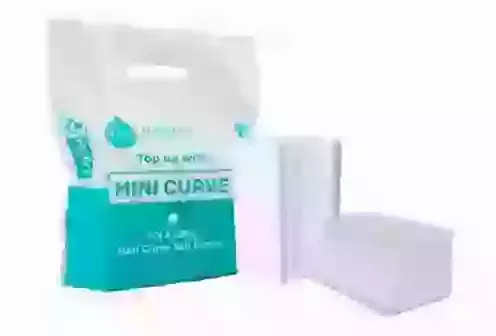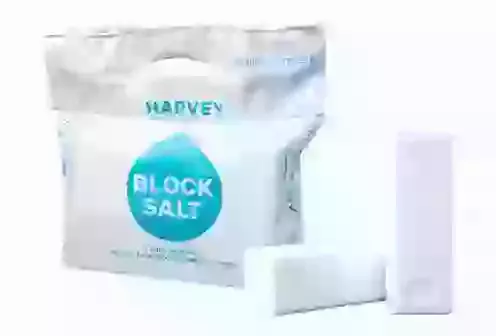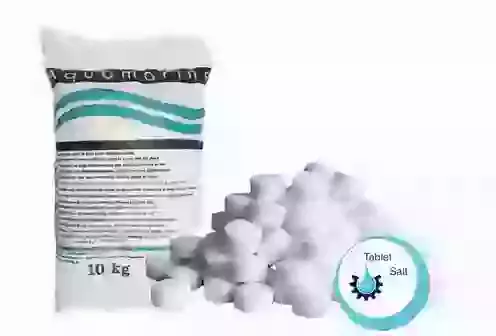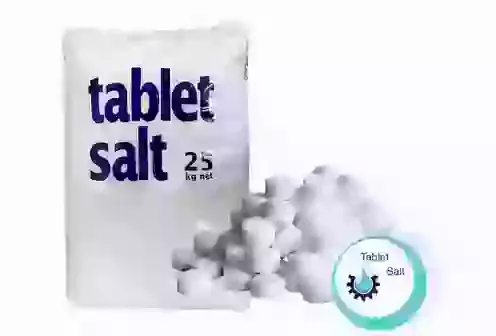Which salt is best for my water softener?
There are different types of water softener salt available in the UK, some of which can be used in water softeners and others that definitely shouldn’t.
For many years, the only salt available for water softeners was granular salt, but this tended to create a mess, so tablet salt was created.
Tablet salt has been prevalent for many years. Until the development of Harvey block salt, it was the biggest-selling salt in the market, both domestically and commercially.
Visit our online shop for tablet salt, Harvey block salt and mini curve block salt. Call us during office hours for advice or help 0800 999 4117.
The reality of granular salt damage becomes clearer
Bit by bit, the use of granular salt has dwindled in favour of tablet salt. It is easier to use and less messy, too.
It wasn’t until recently that the real damage that granular salt causes to softener valves became universally understood. Some individuals in the industry have been talking about their concerns about granular salt for a long time.
It is not recommended to use granular salt in water softeners.
Laurence Willis, Managing Director of ER Longley Hydroworks, recalls:
“I noted very early on in my career that some softeners had scoring on the valves, both plastic and metal. This scoring was caused by fine granules of salt being sucked up by the brine valve and pulled across the valve. This creates a problem because seals then can’t do their job properly, and softeners begin to malfunction. In ideal circumstances, softener brine valves would have a suitable screen to prevent debris ingress and scoring, but all too often, the smaller granules of salt are still making their way through."
"When we bought Hydroworks in 2016, I stopped selling granular salt for softeners and began educating our customers on why tablet salt was a better alternative. Of course, companies often don’t always tell their customers about the damage that granular salt can cause. It keeps service intervals frequent and maintenance costs high, making an extra profit for the service company.”
What should I do if I'm still using granular salt?
If you currently use granular salt, you should move towards tablet salt as soon as possible.
Ideally, the cabinet should be washed out to give your softener the longest life and to remove any sharp granular fines and salt sludge. That would also be an excellent time to clean out the water softener's valve, replace seals, and finally, lubricate to ensure the best performance and longer life.
Hydroworks offers a FREE Health Check, so if you are unsure if you need this done, you are more than welcome to ask us to come and check your softener for you and give you the best advice.
The different salt types for water softeners
Here are the four different types of salt commonly used in water softeners.


There is one salt you should never use in a water softener. We have occasionally been to clients' homes or businesses and found that they have used fine salt in their softeners. The average person would call this type of salt “table salt.”
Fine ‘table salt’ is even more damaging to softeners than granular salt as it is so fine that the brine valve easily sucks it up and will scratch the plastic and metal components and damage the seals and pistons of the water softener.
In the adjacent photo, you can see how small it is compared to granular salt and how small it is compared to tablet salt. Very quickly, we can understand why nothing smaller than tablet salt is recommended in water softeners.

The evolution of water softener block salt
In the mid-1990s, Harvey Bowden of Harvey Softeners (which in those days was trading as Kinetico) had developed a version of the American twin cylinder softener for the UK market and found that customers loved the convenience of these smaller softeners that were nonelectric.
Over dinner one evening, his closest friend, Geoff, suggested it would be fantastic if Harvey could create blocks of salt in the same style as animal salt licks. Harvey loved the idea but found out he could not patent the block salt concept as animal licks of a smilier style were already in use - but that did not deter Harvey, so he created a larger block for water softeners from pure food grade salt.
When water softener block salt first hit the market, it was sold in cardboard boxes, and only one pack has survived the years, which we presented to Harvey a few years ago as thanks for all his support. Harvey’s traditional softener competitors tried for years to disrupt block salt softener sales by telling customers that the cost of block salt would increase exponentially once the customer had a block salt softener. However, quite the opposite has happened. Harvey surprised the market by ensuring that block salt prices haven't gone up significantly, regardless of what happens to salt pricing in the UK. Buy water softener salt.

The Different Grades of Water Softener Salt

At this point, the whole discussion on salt for softeners becomes a bit more complicated.
Water softener salts should be Food Grade salt which is a crystalline product consisting predominantly of sodium chloride. Most food-grade salt is evaporated and heated and evaporated to crystallise the salt.
Put simply; water softener salt is then graded into two categories:
Grade A
Grade A quality salt is either PDV (Pure Dried Vacuum from Natural Brine Solution) or Mined from underground rock salt deposits. This is the best salt for water softeners and will prolong the machine's life.
Grade B
Grade B quality is either obtained from the sea (Marine), or is PDV (Pure Dried Vacuum from Marine salt). This salt is available for use in softeners, but beware, some manufacturers will invalidate your warranty if used. If you are going to use it, the rule of thumb is to use it with caution and, at the very least, ensure it is PDV Grade! It can reduce the machine's life and almost certainly will increase maintenance costs and frequency.
How is Grade A PDV salt typically created?
Grade A PDV is created by pumping water into underground salt deposits to make a brine. Another way it is created is by doing this in exactly the same way above ground in large storage tanks, as is the process done by British Salt in Cheshire.

The brine is then evaporated into large-scale evaporators using heat from natural gas for Grade A salt and natural solar heat in Grade B salt.

Grade A PDV salt has a purity of 99.6% - 99.9% sodium chloride and is less than 0.01% insoluble.


Why is Grade B PDV (Marine) salt less pure?
Grade B salt comes from seawater which is directed into large outdoor ponds. Using just the sun, wind and time, the water evaporates, and salt crystals are left behind. The salt is then washed and processed into granular, tablet, or block forms. Marine salt contains impurities, making the salt darker as it dissolves, resulting in a scum forming on the top and around water softener brine tanks. You can get PDV from sea salt, which makes it purer, but it still suffers from a quality point of view and is classed a Grade B quality.
-
 Marine salt collection.
Marine salt collection. -
 Marine salt close up.
Marine salt close up.

IMPORTANT: The marine salt used in water softeners should be a minimum of Grade B, and all single-cylinder manufacturers have indicated (by way of no comment) that they are satisfied that this salt is pure enough for their equipment.
Both Harvey Softeners and Kinetico have stated that if Grade B salt is used in their softeners (we only sell grade A), this will invalidate the warranty!
Their reason is that block salt softeners work off a pure brine solution at the bottom of the tank, and the level of impurities and scum created will create blockages in their machines and impact the plastics.
Harveys have, in recent years, become so worried about the damage that the impure salt is causing that they have now created a new patented smaller curved block salt which enables them to guarantee the quality and thus protect the customer guarantee. You will, however, need one of their new machines, such as the Minimax Innova, for this salt. If you have one of their older models, just make sure you purchase a Harveys, Aquasol or Kinetico branded salt.

An example of Grade B Block Salt
Here is a customer's home we were in recently. They have been using Grade B block salt.
They have only been using this salt for a short period, so we have been able to give them the right advice and clean out their cabinet and brine system. The black build-up in the bottom of the brine system is very damaging to block salt softeners that operate on a pure brine solution. It is so damaging because it coats the plastics of the softener with a marine slime, impacting the ability of the softener to work.
Once again, if you are in doubt, Hydroworks offer a FREE Health Check; you are more than welcome to ask us to come and check your softener for you and give you the best advice.

Tablet Salt for softeners
As mentioned previously above, single-cylinder softener manufacturers have tended not to comment on the type of salt that is suitable for their softeners; for many years, Hydroworks have used a Marine Grade A & B salt in those softeners without any degradation to the quality of softened water or any obvious damage to the machines.
We have noted, however, that as water softeners become more popular across Britain and Europe, there are many more imported salts entering the UK as companies jump into the salt manufacturing fray, and this has inevitably seen a direct link to a degrading of salt quality.
Tablet salt comes in both easy-to-lift 10kg bags and 25kg bags. The smaller 10kg bags cost slightly more, but the convenience often outweighs the small price differential between those and the larger 25kg bags.

Block Salt for softeners
Water softener block salt is sold in either 8 kg packs or 4.3 kg packs. The heavier 8 kg packs are made for all older model block salt softeners, including Kinetico models. The Lighter weight 4.3kg pack is specifically made for the Harveys Arc, the Minimax Innova and the TwinTec Cobalt (or S5).
Both block and curved block salt should cost the same, kilo for kilo.
The reason that Harvey softeners created the curved block salt was that they were increasingly getting requests from customers for a lighter weight block, and this gave them a double opportunity to guarantee sort quality by taking control of the salt manufacturing process, which they did in the beginning when they first invented the original block salt. The difference is that this time they've been able to patent the salt. It is commonly felt within the industry that this is the ideal solution, as increasingly, poorer quality block salt is entering the UK market that is damaging machines and impacting voiding customers' warranties.
The new curve salt can fit easily in some older block salt softener machines such as Kinetico softeners, so if a customer wishes to purchase the lighter weight salt, that may be possible.










